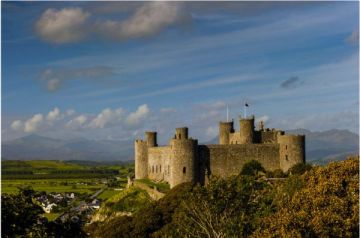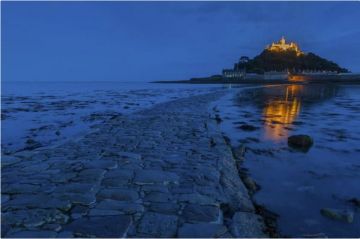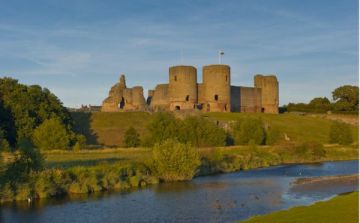<< Back - VIRTUAL TOUR - Next >>

Cardiff, located on the banks of the River Taff, is the capital and largest city (320,000+ inhabitants) of Wales. It's a busy commercial, maritime and university city.
During Victorian times it was the biggest coal-exporting city in the world. Cardiff's most famous citizen was the wealthy second Marquess of Bute, who, in 1839, built Cardiff's docks to export the coal mined from his father's valley lands.
He amassed a fortune, which the third Marquess took advantage of to build the eye-stunning Cardiff Castle on medieval foundations within a Norman wall. He enlisted William Burges as his architect and built the castle with every conceivable decoration possible in its interior.
The castle is located in the city centre within the site used by both the Romans and the Normans for defensive purposes. The 12-sided Norman keep still sits on top of a small hill today, providing views over Cardiff.

Cardiff's Civic Centre, enriched with white Portland stone buildings, is northeast of the castle. Cathays Park, part of the Centre, has gardens, trees and green spaces. The City Hall (look for the dragon on the domed rooftop), Law Courts and Welsh National War Memorial are in the park, but it's the National Museum of Wales that is of most interest to visit. It tells the story of the evolution of Wales from the land's beginning and houses a large collection of 18th-century porcelain. There are art galleries of European work, including Impressionist paintings and sculpture. Natural history and archaeological exhibits are part of the museum displays.
The Museum of Welsh Life, 4 miles from the city centre at St Fagans, is a 100-acre (40.5ha) open-air museum of reconstructed buildings gathered from all over Wales. They vary from St Fagan's Castle, a late 16th-century manor house, to an original pigsty. An indoor museum on the site houses farming implements, costumes and artefacts of daily living from the middle ages to today.

The Glamorgan Heritage Coast is a 14 mile (22.5km) stretch of protected coast running from Aberthaw to Porthcawl. The area is characterized by the Merthyr Mawr dune lands (some of the largest in Europe), sandy beaches and high cliffs. Merthyr Mawr is said to have the prettiest thatched cottages in all of Wales.
Porthcawl is a traditional seaside resort with sandy beaches and a Victorian/Edwardian street with a promenade. Barry Island (not really an island but a peninsula) is another popular seaside holiday spot for families with its large amusement park. The Heritage Coast Visitor Centre is located at Southerdown.
Llantwit Major, an attractive town with medieval streets, is home to the cathedral-like church of St Illtud. It's really two churches linked with a tower. The 13th-century part has a wall painting of St Christopher, and the 15th-century part is a reconstruction of Norman origin. It contains a number of effigies and early Christian stones and crosses.

The Valleys of South Wales consist of the mountainous landscape to the north of Newport, Cardiff and Swansea. The area's once beautiful green hills are scarred with its industrial past when they yielded millions of tons of coal and iron during Victorian times. Former miners' cottages terrace the hillsides, and old industrial sites are now museums and heritage parks.
Rhondda Heritage Park at Trehafod and Big Pit at Blaenavon (located at the head of the Afon Llwyd Valley) are two to visit. The Rhondda lets visitors experience the life and times of miners over the past 150 years. It's part of the Rhondda Heritage Trail that leads to over 20 sites of industrial, cultural and scenic importance.
The Valley area is home to an impressive 13th-century castle, Caerphilly in the village of the same name. It boasts massive remains and is justly famous for its leaning tower. Surrounded by a moat and lakes, the concentric castle was built as a threat to the Welsh. It contains both an inner and outer ward.
Llancaiach Fawr Manor is a living history museum. On stepping through the door, "17th-century" guides will greet you and tell you all about the life of the times.
For more in-depth information about Cardiff and area:
Glamorgan Travel Guide
Tourist Information Centres
Cardiff Hotels | Self Catering




